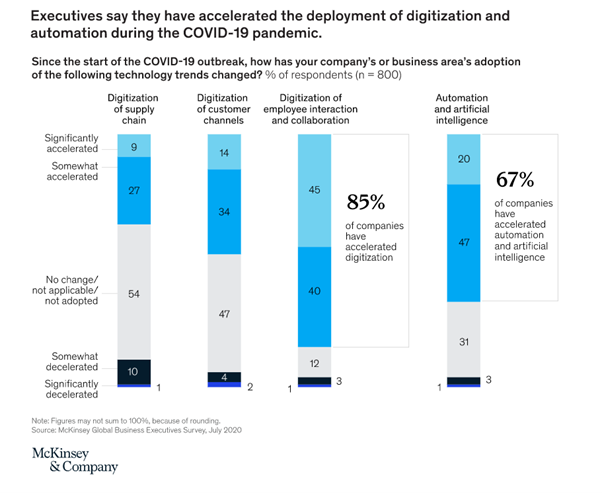Over the last 2 years we have experienced major workplace disruption. According to a 2020 McKinsey survey of senior business executives around the world, many workforce trends were already underway - like the adoption of automation and digitization, and remote working – but the crisis has accelerated the journey for many.

Source: McKinsey
Now, there’s no doubt that hybrid working is here to stay, but what should business leaders be prioritizing to ensure their organizations will move forward, and emerge stronger than ever in today’s tumultuous world?
1. People
Every successful business leader knows that at the heart of any organization is its culture and its teams. Without a strong culture, the survival of a business is shaky, and without support for its workers there will be an enormous, long-lasting impact on that organizational culture.
Create a people-strategy
Solidifying a people-strategy includes three key areas:
- Team cohesion
- Managing people problems
- Reconciling remote work
It’s essential to take stock of the people within an organization and consider their strongest behavioral drivers, their strengths, and the way they complement their teammates.
Give them the tools to get the job done!
Working from home, for example has brought about a huge shift in the way employees communicate and interact. For many businesses, video communication has become the only way for teams, colleagues and clients to stay connected. So, it’s imperative that collaboration tools provide a seamless user experience. A study by GFK showed that inadequately performing collaboration tools can hugely impact businesses through poor employee engagement and high staff turnover.
2. Cost management
Businesses globally are reportedly increasing their spending on digital transformation initiatives. In fact, a report by IDC reveals that businesses will spend $2.3 trillion a year on digital transformation within the next four years.
After months of improvising, CFOs are realizing that as far as budgeting goes, they need to match resources with strategy. But a traditional budgeting process in these uncertain times is no longer fit for the task. According to a McKinsey survey, 65% of 127 CFO respondents anticipated more use of rolling forecasts in 2021 and beyond.
CFOs could incorporate three key strategies to align their budgeting processes with today’s needs:
- Rethink the business from a zero standpoint to determine key business drivers
- Put aside some central spending as contingent resources to build-in some flexibility and optionality
- Try stress-testing scenarios and assumptions to counter uncertainty
Enabling a remote working culture can positively impact cost management by saving on office space, travel costs, commute time and more. But if collaboration tools aren’t functioning properly, it wastes time and potentially makes a huge negative impact on cost management.
3. Maintaining innovation
To thrive in a competitive hybrid landscape, businesses need to adapt and change. Innovation has become a key driver for business recovery, agility, and growth. Its relevance as a growth strategy in today’s business world shouldn’t be underestimated. Successful business innovation involves constantly finding (or creating) new revenue opportunities, and optimizing existing channels to generate higher profits.
If we consider past economic disasters like the 2008 financial crisis, it was found that companies who increased their innovation expenditures during the crisis experienced stronger long-term growth prospects.
Ways in which businesses can look at innovation include:
- Revenue model innovation. This can involve re-assessing products or services, or examining pricing strategies.
- Business model innovation. Organizations can look at which of its products or services can be improved. This could include forming new partnerships, implementing new technologies, or outsourcing.
- Industry model innovation. More ambitious organizations could look at changing their industry completely, or even creating a whole new industry. For example, as Amazon went from a bookstore operating from a garage - to the largest internet retailer in the world.
4. Growth
Innovation inevitably goes hand-in-hand with business growth. Business building has always been an important part of the role of company executives. By using innovative business models, products, and services they’ve been able to meet the challenges and opportunities of a digitizing world. The COVID pandemic has accelerated and intensified that trend. In many industries, the pandemic has rewritten rules and shifted assumptions, as well as threatening existing revenue streams. Replacing that revenue requires finding new ways to grow.
Growth is all about reaching scale, and the most important way to achieve it is by focusing on meaningful metrics, and using data and analytics to understand where to invest resources.
5. Critical Intelligence Observability
A relatively new, though incredibly apt buzz-phrase that applies to IT and cloud computing is Critical Intelligence Observability. The escalation of data and the massive shifting of workloads to the cloud requires continuous intelligence to maintain order.
Most IT, DevOps or business operations teams are in the midst of digital transformation and cloud transformation strategies. With the increasing pace of technology, businesses need an agile data and analytics architecture to support the constant change.
An organization’s success depends on delivering high-value digital experiences to customers and internal users – but these dynamic environments create a scale of complexity and frequency of change that can be difficult to manage. The significance of an outage, for example, or a failed video connection, bad quality audio, the need for software updates, or security breaches, can all have a huge negative impact on a business.
Leaders today must ensure their workforces are equipped with the right tools, that work seamlessly, to ensure their people remain engaged and business objectives can be achieved, so that they can survive and thrive in a hybrid working world.
Want to know about working effectively in a hybrid world? Watch our webinar and find out 'How To Hybrid'




